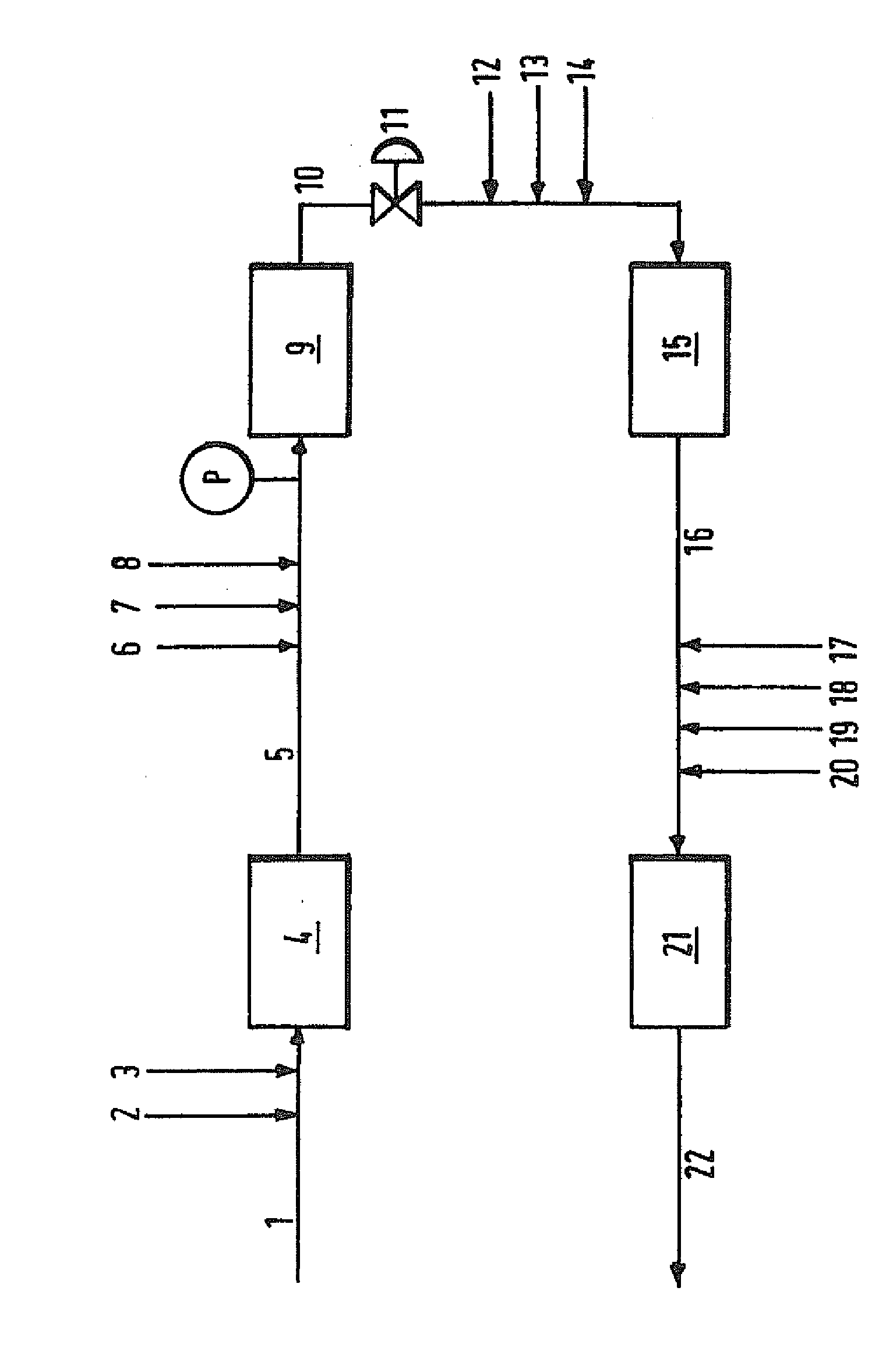Process For Making Silicone Emulsions
a technology of silicone and water emulsion, which is applied in the direction of colloidal chemistry, other chemical processes, hair cosmetics, etc., can solve the problems of yield stress, risk of uneven mixing or localised overheating,
- Summary
- Abstract
- Description
- Claims
- Application Information
AI Technical Summary
Benefits of technology
Problems solved by technology
Method used
Image
Examples
examples 1 and 2
[0045]These Examples describe the preparation of an emulsion from a hydroxy-terminated polydimethylsiloxane fluid of viscosity 60 Pa·s. Both Examples prepared a thick oil in water emulsion continuously in a high shear dynamic mixer (9). In Example 1 the thick phase was diluted batchwise in a dilution tank. In Example 2 the thick phase was diluted continuously. The amounts of materials added through different lines are shown in Table 1 below.
TABLE 1Example 1Example 2ReferenceReferenceMaterialWeight %in FigureWeight %in FigurePolysiloxane fluid601 = 5601 = 5Cocoalkyl pentaethoxy1.961.96methyl ammoniummethosulphate (purecationic-surfactant)Coco trimethyl1.9371.937ammonium methosulfate(30% active aqueouscationic surfactant)Coco trimethyl5.87Dilution5.8713ammonium methosulfatetank(30% active)Demineralised water29.2dil tank21.612Demineralised water7.617Silicone antifoam0.1dil tank0.118Glycacil L0.1dil tank0.119(preservative)Phenoxyethanol0.9dil tank0.920(preservative)
[0046]The premix mixe...
examples 3 and 4
[0050]Emulsions were produced by the process of EP874017 in which a chain extension reaction is carried out during emulsification. In both Examples the polysiloxane fluid comprised a vinyl-terminated linear polysiloxane of viscosity 10 Pa·s and a SiH-terminated short chain linear polysiloxane of viscosity 10 mPa·s. Both Examples prepared a thick oil in water emulsion continuously in a high shear dynamic mixer (9), although this emulsion was less viscous than the thick phase of Example 1. In Example 3 the thick phase was diluted batchwise. In Example 4 the thick phase was diluted continuously. The amounts of materials added through different lines are shown in Table 2 below.
TABLE 2Example 3Example 4ReferenceReferenceMaterialWeight %in FigureWeight %in FigureVinyl polysiloxane651651SiH polysiloxane2.0422.042Hexadecyl trimethyl7.867.86ammonium chloride(29% active aqueouscationic surfactant)Demineralised water108108Demineralised water14dilution1412tankPlatinum complex0.031 ofdil tank0.0...
examples 5 and 6
[0054]Following the general procedure of Example 1, a thick phase silicone oil in water emulsion was produced from a trimethylsilyl-terminated polydimethylsiloxane fluid of viscosity 1 Pa·s by feeding the ingredients shown in Table 3 below. A static mixer was inserted in line (5) after surfactant feed (6) and before surfactant feed (7) so that the surfactant added at (6) was pre-dispersed in the polysiloxane fluid.
TABLE 3Example 5Example 6% byReference% byReferenceweightin Figureweightin FigurePolysiloxane fluid86.0186.01Sodium N-lauroyl6.566.57sarcosinate 35%aqueous anionicsurfactantTridecanol7.577.56ethoxylate(7)85% aqueousnonionic surfactant
[0055]The thick phase was diluted in a dilution tank as described in Example 1. Particle size analysis of the emulsions produced gave the following results:
PUM
| Property | Measurement | Unit |
|---|---|---|
| viscosity | aaaaa | aaaaa |
| viscosity | aaaaa | aaaaa |
| viscosity | aaaaa | aaaaa |
Abstract
Description
Claims
Application Information
 Login to View More
Login to View More - R&D
- Intellectual Property
- Life Sciences
- Materials
- Tech Scout
- Unparalleled Data Quality
- Higher Quality Content
- 60% Fewer Hallucinations
Browse by: Latest US Patents, China's latest patents, Technical Efficacy Thesaurus, Application Domain, Technology Topic, Popular Technical Reports.
© 2025 PatSnap. All rights reserved.Legal|Privacy policy|Modern Slavery Act Transparency Statement|Sitemap|About US| Contact US: help@patsnap.com

